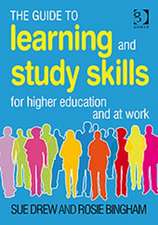The Past, Present, and Future of the Business School
Autor Edward W. Milesen Limba Engleză Hardback – 12 oct 2016
This book examines the criticism that modern business schools face and how these obstacles have evolved throughout history. Through historical, resource, and professional school contexts, it sheds light on the operating environment of the business school and the challenges endemic to various university-based professional schools, exploring the likelihood that potential interventions will result in success or failure.
Business schools are often accused of inhibiting the practice of business by producing research that is irrelevant and does not address real concerns facing managers. This book investigates these accusations by outlining the historical values on which academic institutions are based, the resources and funding available today, and comparisons to other professional schools which undergo a similar level of scrutiny. This extensive coverage will help academics, administrators, faculty, and policy makers with the tools to understand better the ill-will towards business schools in today’s university structure, and ultimately to deliver on the benefits they provide to stakeholders.
Toate formatele și edițiile
| Toate formatele și edițiile | Preț | Express |
|---|---|---|
| Paperback (1) | 630.15 lei 6-8 săpt. | |
| Springer International Publishing – 16 iun 2018 | 630.15 lei 6-8 săpt. | |
| Hardback (1) | 634.38 lei 6-8 săpt. | |
| Springer International Publishing – 12 oct 2016 | 634.38 lei 6-8 săpt. |
Preț: 634.38 lei
Preț vechi: 746.33 lei
-15% Nou
Puncte Express: 952
Preț estimativ în valută:
121.47€ • 125.30$ • 100.68£
121.47€ • 125.30$ • 100.68£
Carte tipărită la comandă
Livrare economică 21 februarie-07 martie
Preluare comenzi: 021 569.72.76
Specificații
ISBN-13: 9783319336381
ISBN-10: 331933638X
Pagini: 192
Ilustrații: XIX, 196 p. 3 illus., 2 illus. in color.
Dimensiuni: 148 x 210 x 18 mm
Greutate: 0.38 kg
Ediția:1st ed. 2016
Editura: Springer International Publishing
Colecția Palgrave Macmillan
Locul publicării:Cham, Switzerland
ISBN-10: 331933638X
Pagini: 192
Ilustrații: XIX, 196 p. 3 illus., 2 illus. in color.
Dimensiuni: 148 x 210 x 18 mm
Greutate: 0.38 kg
Ediția:1st ed. 2016
Editura: Springer International Publishing
Colecția Palgrave Macmillan
Locul publicării:Cham, Switzerland
Cuprins
1. Introduction.- 2. Higher Education from Antiquity to the Medieval University.- 3. Medieval Craft Guilds Died Out in Business, but They Are Alive and Thriving in Business Schools.- 4. Critical Juncture I: The Pseudo-Humboldtian Influence.- 5. The Purpose of the University.- 6. Critical Juncture II: Mass Education and the Demise of the Humboldtian University: The Great Paradox—University in Ruin Caused by Its Own Success.- 7. Prestige and Prestige-Seeking in Universities.- 8. Critical Juncture III: The 1959 Foundation Reports: Throwing Out the Baby with the Bath Water?.- 9. Prestige-Seeking by Business Schools.- 10. Credentialing: Safe for Another 800 Years?.- 11. Professions, Professional Schools, and Business as a Profession.- 12. Professional Schools Displace Practice-Based Training.- 13. Lessons from University-Based Journalism Schools and Law Schools.- 14. Lessons from University-Based Medical Schools.- 15.Critical Juncture IV: The State’s Reduction in Munificence.- 16. Another Paradox: The Business School in Ruins.
Notă biografică
Edward W. Miles is the Faculty Director of MBA Programs in the Robinson College of Business at Georgia State University, USA, where he has taught for over 25 years. Prior to that, he was on the faculty of the College of Commerce at Clemson University, USA.
Textul de pe ultima copertă
This book examines the criticism that modern business schools face and how these obstacles have evolved throughout history. Through historical, resource, and professional school contexts, it sheds light on the operating environment of the business school and the challenges endemic to various university-based professional schools, exploring the likelihood that potential interventions will result in success or failure.
Business schools are often accused of inhibiting the practice of business by producing research that is irrelevant and does not address real concerns facing managers. This book investigates these accusations by outlining the historical values on which academic institutions are based, the resources and funding available today, and comparisons to other professional schools which undergo a similar level of scrutiny. This extensive coverage will help academics, administrators, faculty, and policy makers with the tools to understand better the ill-will towards businessschools in today’s university structure, and ultimately to deliver on the benefits they provide to stakeholders.
Business schools are often accused of inhibiting the practice of business by producing research that is irrelevant and does not address real concerns facing managers. This book investigates these accusations by outlining the historical values on which academic institutions are based, the resources and funding available today, and comparisons to other professional schools which undergo a similar level of scrutiny. This extensive coverage will help academics, administrators, faculty, and policy makers with the tools to understand better the ill-will towards businessschools in today’s university structure, and ultimately to deliver on the benefits they provide to stakeholders.
Caracteristici
Maps out the historical development of the university from medieval times to the modern structure Compares and contrasts the challenges faced by business schools with other professional university programs Discusses the roots of the criticisms about university-based business schools through historical, resource, and professional lenses










